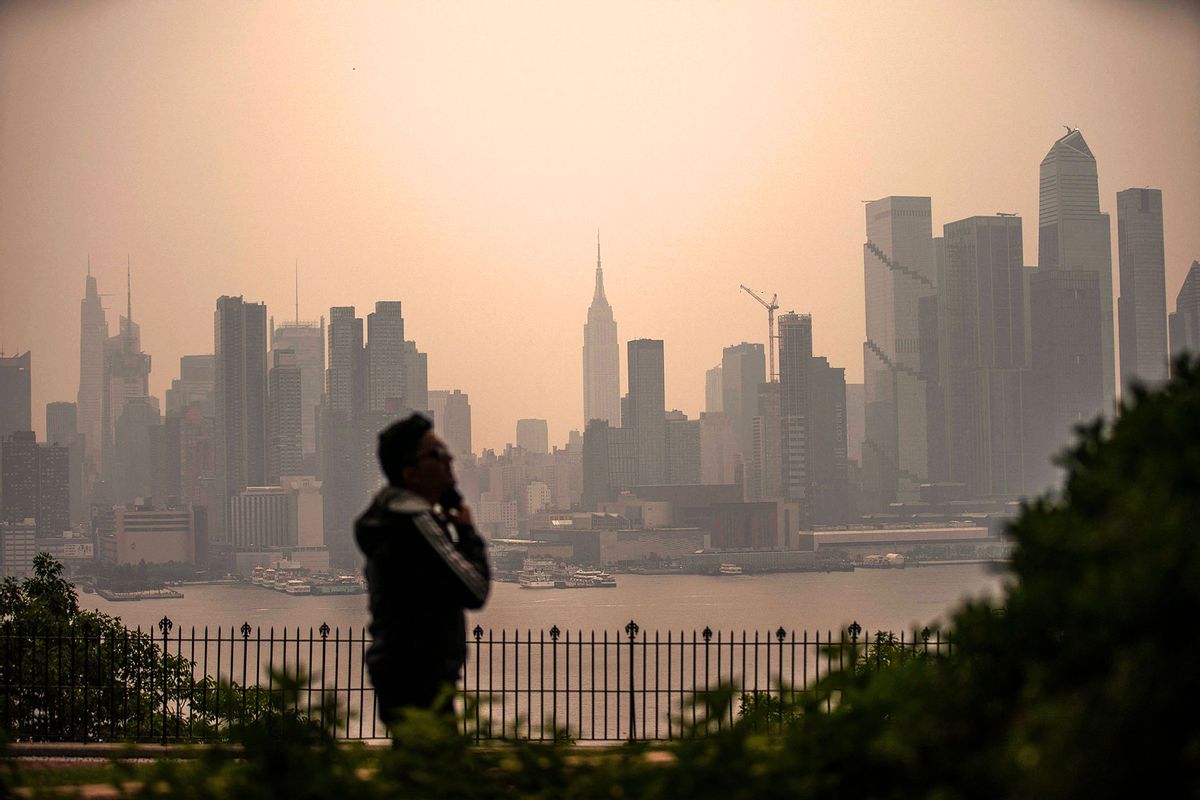New York City residents have been experiencing a shocking decline in air quality, ranking the city among the worst polluted globally. The cause, of course, is a smoggy blanket of fumes from wildfires in Canada that have been drifting south, muting the sun and tinting the sky a foreboding apricot hue.
At one point Wednesday afternoon, IQAir, a Swiss air quality technology company, reported that NYC had an air quality index of 353, which is more than double that of Dubai, United Arab Emirates and Delhi, India, two mega-cities often cursed with the world's most terrible air. A good air quality index is around 50 or below. According to IQAir, the air is so bad in NYC, it's gone from an "unhealthy" tier into straight up "hazardous" territory.
The crisis, which is impacting at least 17 other states and 100 million people, has spurred evacuations in some Canadian towns and forced people indoors elsewhere. It has also grounded airplanes, postponed basketball and baseball games, and prompted the Biden Administration to send firefighters to the Great North to battle the blaze.
"The bottom line is this: If you can stay indoors, stay indoors," New York Governor Kathy Hochul said in a press conference, seemingly ignoring the roughly 70,000 unhoused people in the city who don't have an option to flee the smoke. "You may not see it, you may not even feel it, but it is having a negative effect on everyone, so please take precautions," Hochul urged.
Despite it being only June, this fire season has already proven to be the most destructive in Canada's recorded history. More than 400 fires are currently raging across the country, charring some 9 million acres so far and displacing at least 20,000 people, according to the Associated Press. In Quebec alone, around 150 fires are active, with many sparking in recent days or weeks. The New York Times reports a storm system off the coast of Nova Scotia is driving the smoke southeast.
How does wildfire smoke harm you?
Technically, the only thing you should ever put in your lungs is pure air: oxygen, nitrogen, CO2 and a few other natural gases. Wildfire smoke is chock full of PM2.5 objects, which are tiny specks of particulate matter 2.5 micrometers or smaller in diameter.
The U.S. Environmental Protection Agency warns that PM2.5 can be sucked deep into the lungs, where it can enter the bloodstream and trigger a range of health problems: everything from persistent coughing, difficulty breathing and decreased lung function to intense asthma and the development of chronic respiratory diseases. Even healthy people are at risk of developing lung damage and heart problems from breathing this air.
"This has been a perfect weather scenario to create extremely unhealthy air"
How can you protect yourself from wildfire smoke?
One of the first and most obvious steps to avoid the smoke is to stay inside, but this is of course an option for those privileged enough to do so. Wearing a respirator or the same kind of mask useful for preventing the spread of COVID and other airborne diseases can also help, especially N95 or KN95 grade masks. Indoor air purifiers are another helpful tool for improving indoor air quality, but short from leaving the city, there's not much else that can be done but wait for air quality to improve.
How long will the smoke last?
Unfortunately, experts don't expect the smoke to clear up for a few days. New Yorkers can expect air quality to slowly improve throughout the day Thursday, according to a New York Times analysis, while Washington, D.C. can expect more smoke to arrive through the week as it drifts down the East Coast. Parts of the Midwest have also caught some of the smog, with more predicted.
"This has been a perfect weather scenario to create extremely unhealthy air," Judson Jones is a meteorologist and reporter for The Times, wrote on June 7. "Strong wind has kept the smoke together and nearer to the surface as it pushed into the United States. If there had been calmer winds, the smoke would have risen and dispersed more in the atmosphere, making it less concentrated."
What caused all this?
It may not surprise many folks, but climate change is one of the primary factors driving freak wildfires like those in Canada. The overconsumption of fossil fuels is heating our atmosphere, drying out forests and priming them for catastrophic ignition. These trees aren't recovering quickly enough, creating a positive feedback loop that creates more ideal conditions for future fires.
Yes, it's true that forest fires are a natural phenomenon, but the intensity of wildfires has increased with the uptick in global temperatures. While city-clogging wildfire exhaust is generally a phenomenon experienced on North America's west coast, it's not "normal" to be saturated with this much fire and smoke.
Likewise, pandemics, including COVID and bird flu, can be linked to shrinking, decimated ecosystems. In both cases, smoke or airborne disease, wearing a mask is a critical form of protection, one that will only become more compulsory until climate change is effectively rolled back.

Shares